A creaky box spring can get incredibly annoying, especially if you share the bed with another person.
Every time you climb on the bed or one of you changes position, the bed makes a squeaking sound.
There’s nothing worse than waking up in the middle of the night because of noise from your bed.
But it does happen, to both old and new box spring beds. The good news is, it’s usually easy to fix with household methods.
So, do you want to know how to fix a squeaky box spring? Here are our best DIY tips:
- Find the source of the noise.
- Tighten up and lubricate loose joints.
- Add bolts and screws.
- Use clothes or wax as padding.
- Use plywood as a buffer.
- Flip your box spring.
Your box spring can be made from a number of different materials, and this affects the technique you need to use.
When you inspect it, you’ll likely find a structure made from wood, held together with metal joints, nuts, and bolts.
Depending on the quality, there might also be a lot of cardboard under the cover fabric.
1. Find the Source
First things first: locate the origin of the squeaky noise.
You might have already noticed which part of the bed creaks, but in some cases, it’s not as clear.
It can be tough to locate the problem on your own, so get someone to sit or step on the bed if you can.

As they move around, crouch on the ground to spot the source of the noise.
Pay close attention to places where two pieces of wood or metal meet.
These are the spots where the noise is likely coming from.
2. Tighten Loose Joints
Creaking often comes from a loose joint.
Check out the bed, paying especially close attention to all the corners. Tighten all screws and bolts you can find to reduce movement.
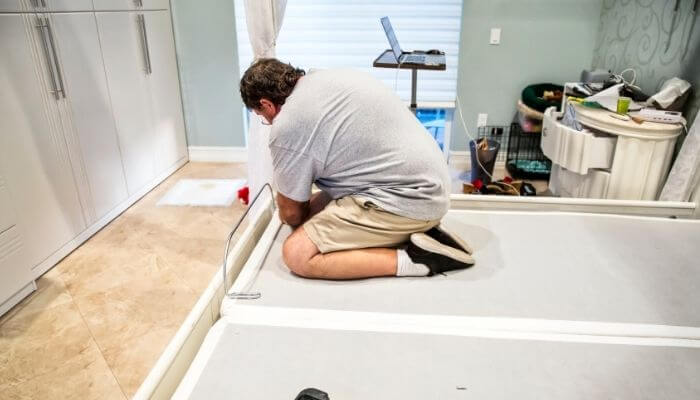
Depending on your box spring, you might need a flat head or Phillips head screwdriver, or a hex wrench for this.
A washer between the bolt and the wood can also help make it tighter.
3. Lubricate the Joints and Coils
If the tightening doesn’t work, you use some oil or WD-40 to lubricate the joints a little and reduce noise-causing friction.
The squeaky sound may also come from the coils themselves.
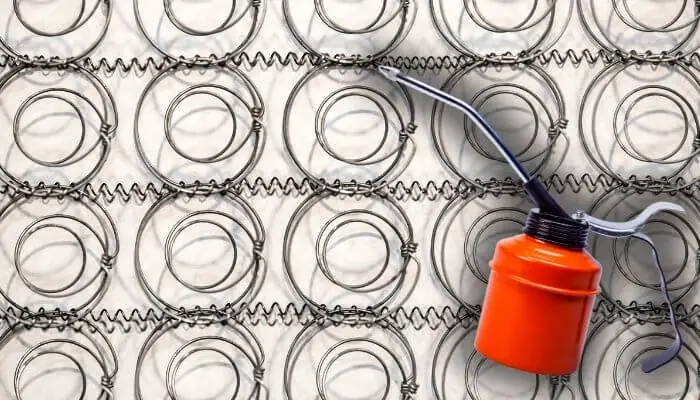
To see the coils, you’ll have to flip the mattress around and possibly remove the covering fabric from the bottom.
Use WD-40 to lubricate all the coils and then stitch the fabric back on to protect them.
4. Add More Bolts and Screws
Sometimes, your box spring might not have enough bolts to hold it together and keep noises to a minimum.
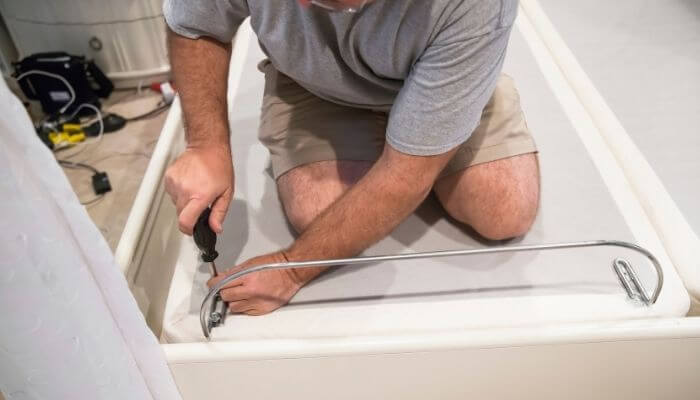
You can strengthen it by adding some new screws and bolts with a handheld drill to all the parts that seem a little too loose. It can be helpful when you want to extend the life of an older bed.
Pay extra attention to the parts close to the legs and the corners, which is where you’ll likely get the most movement.
5. Pad the Squeaky Parts
You might also get some noise between the box spring and the bed frame, or between the parts of the box.
Wherever there’s too much room between two pieces of wood, there’s a risk of movement.
Try reducing the friction by stuffing some old clothes, such as socks or t-shirts, in the small cracks between the pieces of wood or metal. You can also use some cork roll as padding.
Just make sure you’re padding the box evenly and that you don’t go overboard. If you add too much padding, you might end up loosening or deforming the box instead of fixing it.
6. Use Glue
A little bit of wood glue can also stop the joints of your box spring from moving and reduce friction.
Glue is the easiest and often safest way, but if you want to try this purely with household items, candle wax can help.
First, you’ll need to locate the spot where you need to use it. It will be helpful to flip the box spring around, so you have good access to all the joints.
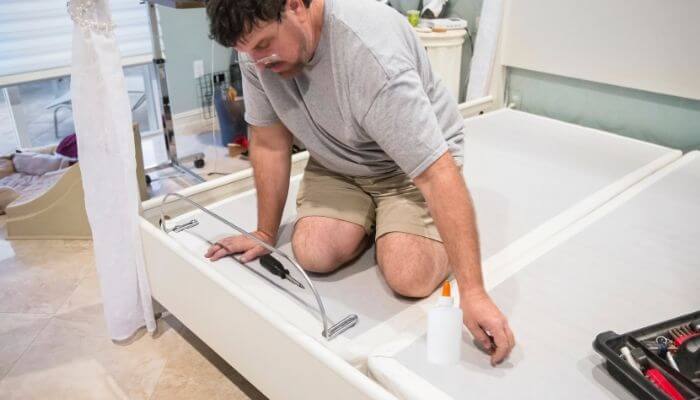
Apply glue generously on the slats, especially where they meet the box spring frame, and let it dry.
If you go with a candle, you’ll have to light it up and wait for the wax to melt.
Then, pour some on a safe and non-flammable surface and wait until it cools off enough to handle it with your fingers. Use some latex cleaning gloves to protect your hands.
Push some wax onto any of the tiny creases of the box spring.
Go through all the problematic spots, like the joints and corners, and let the wax cool before you flip the mattress back around.
7. Add a Layer of Plywood
Sometimes, a layer of plywood between the mattress and the box spring can help you reduce the noise.
This can also help dampen the movement of a mattress that’s too soft for your body.
If you suffer from back pain, it can be helpful to give your bed some more firmness.
You can usually get plywood directly cut to your bed’s size at no extra cost at your local home improvement shop when you buy it there.
8. Flip It
Sometimes, just changing the position of your box spring can move the pressure from the noisy part and fix the squeak.
Take the mattress off and turn the box spring around, the head side towards the feet and vice versa. Then, get on the bed and test it out.
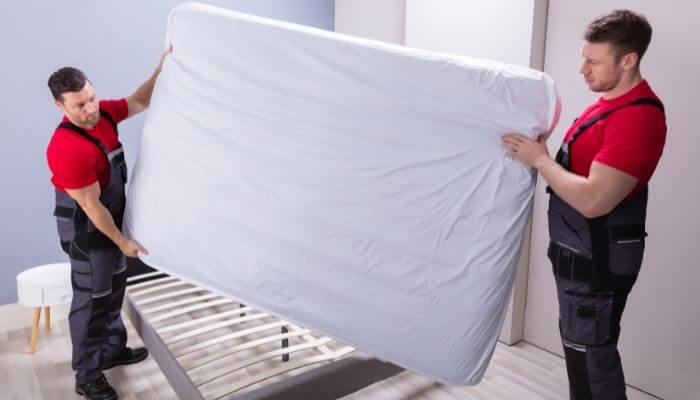
Remember to also flip your mattress regularly to make sure it wears evenly and to reduce your risk of getting squeaks in the future.
It can still happen later on, especially when your box spring has been used for several years. But this way, you’ll likely end up extending the usable life of the mattress.
Is It Time for a New Box Spring?
A new box spring can be creaky, too.
However, beds do tend to get noisier as the years go by. If you can’t fix the noise in your box spring, it might be time to change it for a new one.
An old box spring isn’t just annoying because of its squeaking, it also doesn’t protect your mattress from wear and tear.
Do You Need a Box Spring?
A box spring is good to have to protect your innerspring mattress, so it doesn’t start sagging in the middle. Metal rail bed frames are also designed to go together with box springs.
Box springs absorb a part of the impact and help spread the weight evenly across the bed.
They also add some more height to the mattress so you don’t have to sleep on the floor.
However, box springs aren’t always necessary. A thick and structured mattress or a box bed with a wooden structure doesn’t necessarily require one.
If you have a newer memory foam or latex mattress, you probably shouldn’t use a box spring. The slats on your old box spring can be so far apart that the mattress will start to sag.
Check your mattress manufacturer’s recommendations before buying one to make sure you’re keeping your mattress in optimal condition for longer.
The Takeaway
A squeaky box spring is annoying, but it’s often fixable with some quick DIY methods.
If you’re trying to find out how to fix a squeaky box spring, the most important thing is to find the source of the noise.
When you find a spot where two pieces of the frame are rubbing together and causing friction, make sure to tighten all the bolts and screws. If that doesn’t work, try lubricating the joints and coils.
If the problem still doesn’t get solved, add some clothing or wax to act as padding. You can also buy some cork and stuff it between the bed frame and box spring to reduce movement.
As an Amazon Associate I may earn a small fee from qualifying purchases at no extra cost to you. This helps us run the site, so thanks for your support!